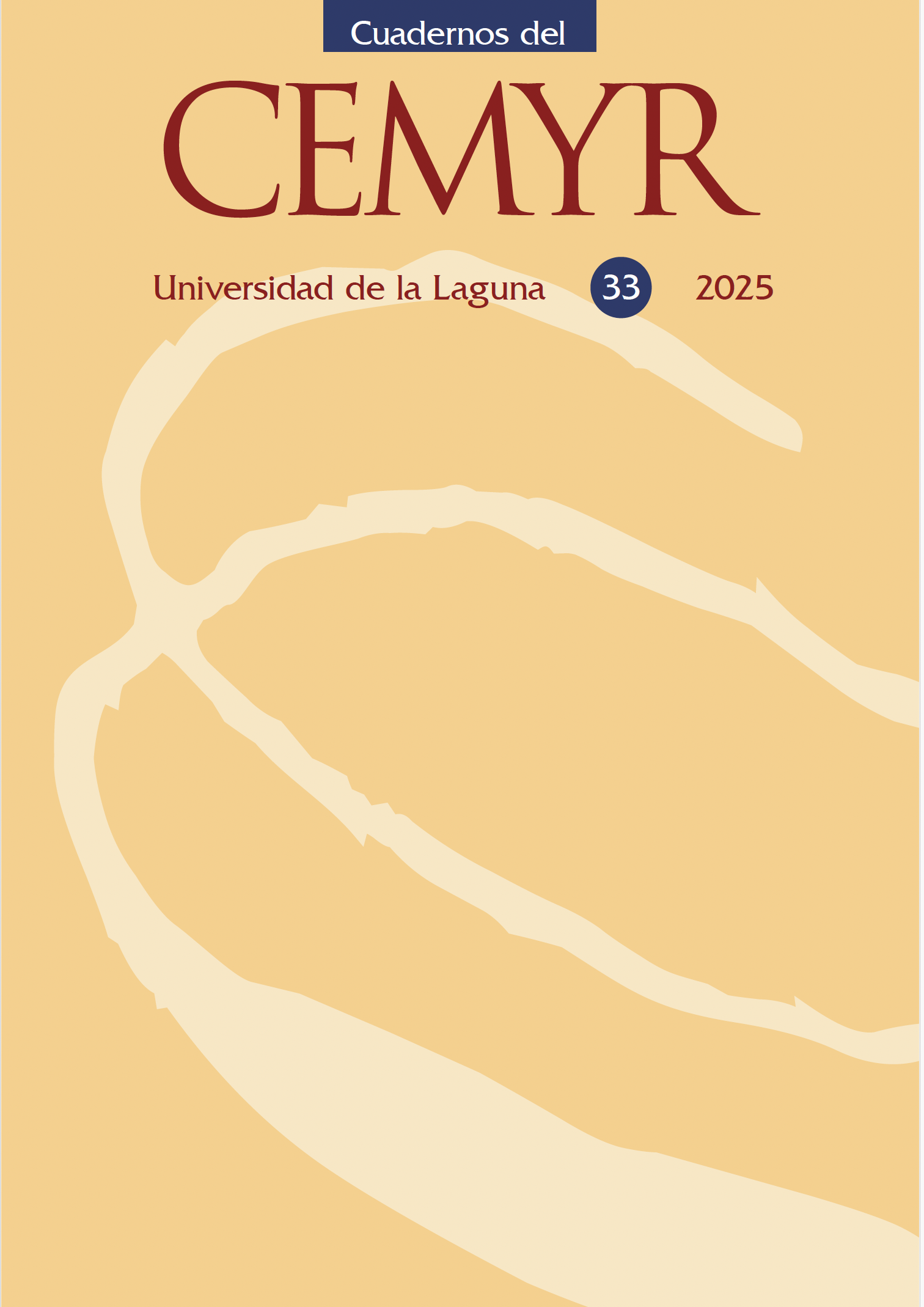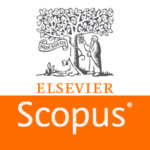La percepción del espacio geográfico en la Inglaterra altomedieval:
paisajes imaginarios y domésticos en el manuscrito Cotton Tiberius B .v/1
Resumen
Este trabajo explora la percepción y sistematización del espacio geográfico en la Inglaterra an- glosajona, especialmente en el siglo XI, a partir del análisis de algunos textos clave procedentes del manuscrito Cotton Tiberius B.v/1, de la Biblioteca Británica de Londres. Se trata de una colección miscelánea con algunos documentos de interés geográfico, entre los que destacan versiones en latín e inglés antiguo de The Wonders of the East (ff. 78v-87v) y un mappa mundi (f. 56v). El primer texto permite profundizar en la percepción de los espacios remotos, prin- cipalmente a partir de la descripción de las criaturas maravillosas (mirabilia) y legendarias que habitan en ellos. The Wonders of the East incluye también referencias a lugares concretos con resonancias exóticas, muchos de ellos inventados, y describe construcciones y paisajes insólitos y lujosos. Por su parte, el mappa mundi se centra en el mundo conocido (la ecúmene), cuyos accidentes y ciudades son profusamente etiquetados; de este modo se puede percibir de pri- mera mano el conocimiento geográfico en la Inglaterra del siglo XI. En este contexto, resulta llamativa la relevancia que adquieren en el mapa la Germania septentrional, Escandinavia y, especialmente, Gran Bretaña e Irlanda.
Citas
Appleton, Helen (2018). «The Northern World of the Anglo-Saxon mappa mundi. Anglo-Saxon England, 46, 275-305. DOI: https://doi.org/10.1017/S0263675119000061.
Appleton, Helen (2022). «Mapping Empire: Two World Maps in Early England», en Atherton, Mark, Karasawa, Kazumoto y Leneghan, Francis, (eds.). Ideas of the World in Early Medieval Literature (pp. 309-334). Brepols. DOI: https://doi.org/10.1484/M.SOEL.5.130566.
Arnaud-Lindet, Marie Pierre (ed.) (1990). Orose Histoires Contre les Païens. Tome I, Livres I-III. Les Belles Lettres.
Barney, Stephen A. (ed. y trad.). (2006). The Etymologies of Isidore of Seville. Cambridge University Press. DOI: https://doi.org/10.1017/CBO9780511482113.
Bately, Janet (ed.) ([1980] 2005). The Old English Orosius. Oxford University Press.
Bologna, Corrado (ed.) (1977). Liber Monstrorum de diversis generibus. Libro delle mirabili difformatà. Bompiani.
Chekin, Leonid S. (2006). Northern Eurasia in Medieval Cartography: Inventory, Text, Translation and Commentary. Brepols.
Cotton World Map. (s.f.). «Cotton World Map.jpg». Wikipedia. Wikimedia Commons. https:// es.m.wikipedia.org/wiki/Archivo:Cotton_world_map.jpg.
Cotton World Map Transcript. (s.f.). «Cotton World Map Transcript.png». Wikipedia. Wikimedia Commons. https://commons.wikimedia.org/wiki/File:Cotton-map-transcript.png.
Delano-Smith, Catherine y Kain, Roger J.P. (1999). English Maps. A History. British Library. Discenza, Nicole Guenther y Estes, Heide (2023). Writing the World in Early Medieval England. Cambridge University Press. DOI: https://doi.org/10.1017/9781108943147.
Edson, Evelyn (1997). Mapping Time and Space. How medieval mapmakers viewed their world. British Library.
Ford, A.J. (2015). Marvel and Artefact: ‘The Wonders of the East’ in Its Manuscript Context. Brill.
Foys, Martin (2005). «The Virtual Reality of the Anglo-Saxon Mappa mundi. Literature Compass 1 (1), 1-17. DOI: https://doi.org/10.1111/j.1741-4113.2004.00016.x.
Foys, Martin (2020). «Cotton Zonal Map (BL Cotton, Tiberius B.v. f. 29rv). Description, Sources and Bibliography». Virtual Mappa 2.0. Schoenberg Institute of Manuscript Studies. https://sims2.digitalmappa.org/36.
Foys, Martin, Crossley, Cat y Wacha, Heather (2020). «Cotton World Map (BL Cotton, Tiberius
B.v. f. 56v). Description, Sources and Bibliography». Virtual Mappa 2.0. Schoenberg Institute of Manuscript Studies. https://sims2.digitalmappa.org/36.
Friedman, John B. ([1981] 2000). The Monstrous Races in Medieval Art and Thought. Syracuse University Press. DOI: https://doi.org/10.2307/j.ctv170x50r.
Fulk, R.D. (ed. y trad.). (2010). The Beowulf Manuscript. Harvard University Press.
Gibb, Paul Allen (1977). Wonders of the East. A Critical Edition and Commentary (Tesis doctoral in- édita). Duke University.
Gneuss, Helmut y Lapidge, Michael (2014). Anglo-Saxon Manuscripts. A Bibliographical Handlist of Manuscripts and Manuscript Fragments Written or Owned in England up to 1100. University of Toronto Press. DOI: https://doi.org/10.3138/9781442616288.
Godden, Malcolm R. (ed. y trad.). (2016). The Old English History of the World. An Anglo-Saxon Rewriting of Orosius. Harvard University Press.
Grade, Tiffany J. (2001). «229. London, British Library, Cotton Tiberius B.v., Part I». En Doane, A.N. y Grade, Tiffany J. (Eds.). Anglo-Saxon Manuscripts in Microfiche Facsimile. Vol. 9: Deluxe and Illustrated Manuscripts Containing Technical and Literary Texts. Arizona Center for Medieval and Renaissance Studies. https://journals.lib.sfu.ca/index.php/asmmf/article/view/5643.
Harris, Stephen J. (2001). «The Alfredian world history and Anglo-Saxon identity. Journal of English and Germanic Philology, 100, 482-510. DOI: https://www.jstor.org/stable/27712138.
Harvey, P.D.A. (1991). Medieval Maps. British Library.
Herren, Michael W. (ed. y trad.). (2011). The Cosmography of Aethicus Ister. Brepols.
Hiatt, Alfred (2020). «An Anglo-Saxon World View? The Cotton Mappa Mundi Reassessed», Viator
(1), 93-129. DOI: https://doi.org/10.1484/J.VIATOR.5.128750.
Howe, Nicholas. (2004). «Rome: Capital of Anglo-Saxon England. Journal of Medieval and Early Modern Studies, 34, 47-171. DOI: https://doi.org/10.1215/10829636-34-1-147.
Howe, Nicholas (2008). Writing the Map of Anglo-Saxon England. Essays in Cultural History. Yale University Press. https://www.jstor.org/stable/j.ctt5vkvwx.
Hutton, M., Ogilvie, R.M., Warmington, E.H., Peterson, W. y Winterbottom, M. (eds. y trads.) ([1914] 1980). Tacitus. Vol. 1: Agricola, Germania, Dialogus. William Heinemann.
Kiernan, Kevin S. ([1981] 1996). Beowulf and the Beowulf Manuscript. The University of Michigan Press. DOI: https://doi.org/10.3998/mpub.8599.
Kiernan, Kevin S. e Iacob, Emil (coords.) (s.f.). Electronic Beowulf 4.0. University of Kentucky. https://ebeowulf.uky.edu/ebeo4.0/CD/main.html.
King, John Edward (ed. y trad.) ([1954] 1979). Baeddae Opera Historica. Harvard University Press. Knight, Charles (comp.) (1836). Old England. A Pictorial Museum. Londres: Sangster.
Ladero Quesada, Miguel Ángel (2020). Espacios y viajes. El mundo exterior de los europeos en la edad media. Dykinson.
Lapidge, Michael (2005). The Anglo-Saxon Library. Oxford University Press.
Le Goff, Jacques (1983). «Discorso di Chisura. Popolo e paesi nella cultura altoimedievale. Settimane di studio del Centro italiano di studi sull’alto meioevo, 29, 805-838.
Manuscript-Reg.lat.123 (s.f.). «Manuscript-Reg.lat.123», DVL. Digivatlib. Vatican Library. https://digi.vatlib.it/view/MSS_Reg.lat.123.
Mappa Mundi d’Albi. (s.f.). «Mappa Mundi D’Albi.png». Wikipedia. Wikimedia Commons. https://commons.wikimedia.org/wiki/File:Mappa_mundi_dAlbi.png.
McGurk, Patrick M., Dumville, David N. y Godden, Malcolm R. (eds.) (1982). An Eleventh Century Anglo-Saxon Illustrated Miscellany. British Library Cotton Tiberius B.V. Part 1. Ro- senkilde and Bagger.
Michelet, Fabienne L. (2006). Creation, Migration and Conquest. Imaginary Geography and Sense of Space in Old English Literature. Oxford University Press.
Kim, Susan M. y Mittman, Asa S. (2013). Inconceivable Beasts: The Wonders of the East in the Beowulf Manuscript. Arizona Center for Medieval and Renaissance Studies. DOI: http://dx.doi.org/10.17613/h009-mb87.
Mommsen, Theodor (ed. y trad.) ([1895] 2012). C. Ivlii Solini Collectanea Rerum Memorabilium. Ulan Press.
Moralejo Álvarez, José Luis (ed. y trad.). (2013). Beda el Venerable. Historia eclesiástica del pueblo de los anglos. Akal.
Orchard, Andy (1995). Pride and Prodigies. Studies in the Monsters of the Beowulf Manuscript. D.S. Brewer. https://www.jstor.org/stable/10.3138/j.ctt1287xc6.
Requejo Prieto, J.M. (ed. y trad.) (1981). Cornelio Tácito. Agrícola. Germania. Diálogo sobre los oradores. Gredos.
Rice Holmes, Thomas (ed.) (1914). C. Iuli Commentarii rerum in Gallia Gestarum VII. Oxonii: Typographeo Clarendoniano», en Crane, Gregory R. (coord.), Perseus Digital Library. Tufts University. https://www.perseus.tufts.edu/hopper/text?doc=Perseus:text:1999.02.0002.
Sánchez Salor, Eustaquio (ed. y trad.). (1982). Orosio. Historias Libros I-IV. Gredos. Serena Mazzi, Maria (2018). Los viajeros medievales. Machado.
Sisam, Kenneth (1953). Studies in the History of Old English Literature. Clarendon Press.
Valtonen, Irmeli (2008). The North in the Old English Orosius: A Geographical Narrative in Context. Helsinki: Société Néophilologique.
Villalba Ruiz de Toledo, F. Javier (2007). «La percepción del mundo: los conocimientos geográficos», en Novoa Portela, Feliciano y Villalba Ruiz de Toledo, F. Javier. (eds.), Viajes y viajeros en la Europa Medieval (pp. 21-54). Iunwerg.
Williams, David (1996). Deformed Discourse. The Function of the Monster in Mediaeval Thought and Literature. University of Exeter Press. https://www.jstor.org/stable/j.ctt80hv3.
Woolward, David (1987). «Medieval Mappaemundi», en Harley, J.B. y Woolward, David. (eds.), The History of Cartography. Volume 1: Cartography in Prehistoric, Ancient and Medieval Europe and the Mediterranean (pp. 286-369). The University of Chicago Press.
Zumthor, Paul (1994). La medida del mundo. Representación del espacio en la Edad Media. Cátedra.
Derechos de autor 2025 Juan Camilo Conde-Silvestre, Dr.

Esta obra está bajo licencia internacional Creative Commons Reconocimiento-NoComercial-CompartirIgual 4.0.
Los artículos publicados en Cuadernos del Cemyr se distribuyen a través del portal web del Servicio de Publicaciones de la Universidad de La Laguna y son de libre acceso bajo una licencia Creative Commons Reconocimiento-NoComercial-CompartirIgual 4.0 Internacional (CC BY-NC-SA 4.0).
Los autores conservan los derechos de autor y garantizan a la revista el derecho a hacer la primera publicación del trabajo, así como una licencia Creative Commons que permita a otros compartir el trabajo con un reconocimiento de la autoría del trabajo y la publicación inicial en esta revista científica.
Los autores pueden establecer por separado acuerdos adicionales para la distribución no exclusiva de la versión del trabajo publicado en Cuadernos del Cemyr (por ejemplo, publicarlo en un repositorio institucional o en un libro), con el reconocimiento de su publicación inicial en esta revista.







